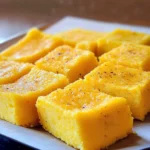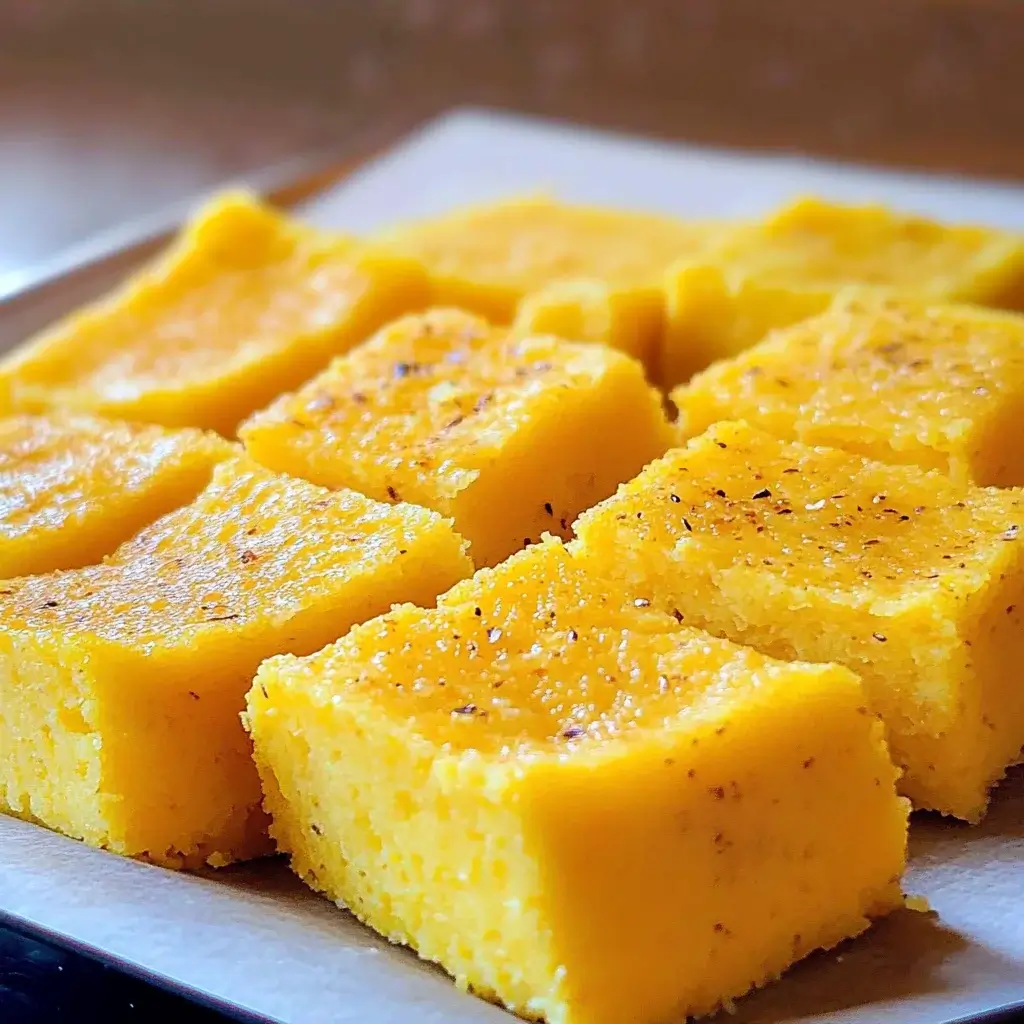There are some dishes that just instantly feel like comfort, like a warm hug on a plate. For my family, these Baked Polenta Squares have become exactly that. I first stumbled upon the idea when looking for a versatile, gluten-free side dish that could work for a casual weeknight dinner but also feel special enough for guests. Honestly, I was a bit intimidated by polenta initially, thinking it was fussy or difficult. How wrong I was! The process of stirring the creamy, golden cornmeal is actually quite meditative, filling the kitchen with a comforting aroma. But the real magic happens after it chills and gets baked. Those humble squares transform into something spectacular – incredibly creamy and soft on the inside, yet delightfully crispy and golden brown on the outside, especially around the edges. The first time I served them alongside a hearty mushroom ragout, my kids, usually skeptical of new textures, devoured them. My husband, a lover of all things crispy, declared them a “top-tier side dish.” Since then, they’ve become a staple. We’ve enjoyed them dipped in marinara sauce as an appetizer, nestled next to roasted chicken, and even topped with a fried egg for a rustic brunch. Their subtle corn flavor and ability to carry other seasonings make them incredibly adaptable. They are surprisingly easy, deeply satisfying, and proof that simple ingredients can create truly memorable food. If you haven’t tried baking polenta this way, you’re in for a treat!
Ingredients
Here’s what you’ll need to create these delicious Baked Polenta Squares:
- 1 cup Polenta (Coarse Grind Yellow Cornmeal): The star of the show. Coarse grind provides a better texture for the final squares compared to fine cornmeal or instant polenta. Ensure it’s labeled “polenta” or “coarse ground cornmeal.”
- 4 cups Liquid (Water, Vegetable Broth, or Chicken Broth): The liquid hydrates the cornmeal. Using broth (vegetable or chicken) instead of water infuses the polenta with a deeper, savory flavor from the start. A 50/50 mix of water and broth also works well.
- 1 teaspoon Salt: Essential for seasoning the polenta properly. Adjust slightly based on the saltiness of your broth, if using. Kosher salt or sea salt is preferred.
- 1/2 teaspoon Black Pepper: Freshly ground black pepper adds a subtle warmth and spice that complements the corn flavor.
- 2 tablespoons Unsalted Butter: Adds richness, flavor, and contributes to a smoother, creamier texture in the cooked polenta. Can be substituted with olive oil for a different flavor profile or vegan butter for a dairy-free version.
- 1/2 cup Grated Parmesan Cheese: Provides a sharp, salty, umami flavor that elevates the polenta. Use freshly grated Parmesan for the best melt and flavor. Pecorino Romano or a good quality aged cheddar can also be used.
- 2 tablespoons Olive Oil (for baking): Used to coat the polenta squares before baking, helping them achieve that desirable crispy, golden-brown exterior. Extra virgin olive oil adds a nice fruity note.
(Optional additions for enhanced flavor):
- 1-2 cloves Garlic, minced: Can be simmered briefly in the liquid before adding polenta for a subtle garlic undertone.
- 1 tablespoon Fresh Herbs, chopped (e.g., rosemary, thyme, sage, parsley): Stirred in with the butter and cheese for fresh, aromatic notes. Dried herbs (about 1 teaspoon) can also be used, added earlier in the cooking process.
- Pinch of Nutmeg: A classic pairing with creamy, cheesy dishes, adding warmth.
- Pinch of Red Pepper Flakes: For a subtle kick of heat.
Instructions
Follow these steps carefully to achieve perfectly creamy-inside, crispy-outside Baked Polenta Squares:
- Prepare the Pan: Lightly grease an 8×8 inch (or 9×9 inch) square baking pan with butter or non-stick spray. You can also line it with parchment paper, leaving an overhang on two sides for easy removal later. This ensures the polenta doesn’t stick and makes cleanup easier. Set aside.
- Bring Liquid to a Simmer: In a medium to large saucepan (heavy-bottomed is best to prevent scorching), combine your chosen liquid (water, broth, or a mix) and salt. Bring the liquid to a gentle simmer over medium-high heat. Don’t bring it to a rolling boil, just hot enough for the polenta to start cooking immediately. If using minced garlic, add it now and let it simmer for a minute to release its fragrance.
- Gradually Whisk in Polenta: Once the liquid is simmering, reduce the heat to medium-low. Slowly pour the polenta into the simmering liquid in a very thin, steady stream while whisking constantly. This gradual addition and constant whisking are crucial to prevent lumps from forming. If you dump it all in at once, you’ll likely end up with clumps.
- Cook the Polenta: Continue whisking constantly as the polenta begins to thicken. This usually takes the first 2-5 minutes. Once it has noticeably thickened, reduce the heat to low to prevent sputtering and scorching. Continue cooking, switching from a whisk to a wooden spoon if needed, stirring frequently (scraping the bottom and corners of the pot) for about 20-30 minutes for traditional coarse polenta. The polenta is done when it’s thick, creamy, and pulls away cleanly from the sides of the pot as you stir. It should taste cooked through, not raw or gritty. Note: Cooking time can vary depending on the specific grind of your polenta – check package directions as a guide, but rely on texture and taste. If using instant polenta, the cooking time will be significantly shorter (follow package instructions), but the texture of the final baked squares might be slightly less robust.
- Stir in Enrichments: Once the polenta is fully cooked, remove the saucepan from the heat. Immediately stir in the unsalted butter, grated Parmesan cheese, black pepper, and any optional fresh herbs or spices (like nutmeg or red pepper flakes) you’re using. Stir vigorously until the butter and cheese are completely melted and incorporated, making the polenta glossy and even richer. Taste and adjust seasoning if necessary (you might need a bit more salt depending on your cheese and broth).
- Pour into Prepared Pan: Quickly pour the hot, cooked polenta into the prepared baking pan. Use a spatula (offset spatulas work great) dipped in cold water or lightly oiled to spread the polenta evenly into the corners and create a smooth, level surface. The smoother the surface now, the neater your squares will be later.
- Chill Thoroughly: Let the pan cool on a wire rack for about 30 minutes at room temperature. Then, cover the pan tightly with plastic wrap (press it directly onto the surface of the polenta to prevent a skin from forming) or aluminum foil. Refrigerate for at least 2 hours, or preferably 3-4 hours, or even overnight. The polenta needs to be completely cold and firm to be cut cleanly. Don’t rush this step!
- Preheat Oven and Prepare Polenta: Once the polenta is fully chilled and firm, preheat your oven to 400°F (200°C). If you lined your pan with parchment, use the overhangs to lift the entire block of polenta out onto a cutting board. If not, carefully run a thin knife or spatula around the edges of the pan and invert the polenta onto the cutting board.
- Cut into Squares: Using a sharp knife (wiping the blade clean between cuts can help), cut the firm polenta block into squares. For an 8×8 inch pan, you can typically cut a 4×4 grid for 16 medium squares, or a 3×3 grid for 9 larger squares. Aim for squares roughly 1.5 to 2 inches in size. You can also cut rectangles or triangles if you prefer.
- Prepare for Baking: Line a large baking sheet with parchment paper for easy cleanup. Arrange the polenta squares on the baking sheet in a single layer, leaving a little space between each square. Overcrowding the pan will cause them to steam rather than crisp up.
- Oil and Season (Optional): Drizzle the tops of the polenta squares generously with the 2 tablespoons of olive oil. Use a pastry brush to ensure each square is lightly coated. You can also sprinkle them lightly with a little extra salt, pepper, or even a pinch more Parmesan cheese or some dried herbs if desired.
- Bake Until Golden and Crispy: Place the baking sheet in the preheated oven. Bake for 30-45 minutes. For even crispiness, carefully flip the squares halfway through the baking time (around the 15-20 minute mark) using a thin spatula. Continue baking until the squares are heated through, beautifully golden brown on the surfaces, and developing crispy edges. The exact time will depend on your oven and the size of your squares.
- Serve: Once baked to perfection, remove the polenta squares from the oven. Let them cool slightly on the baking sheet for a few minutes – they will be very hot. Serve warm.
Nutrition Facts
- Servings: This recipe typically yields 4-6 servings, depending on whether it’s served as a main component or a side dish (based on cutting into 9-16 squares).
- Calories per serving (approximate): Around 250-350 calories per serving (assuming 6 servings), varying based on the type of liquid (water vs. broth) and amount of cheese/butter used.
Here are key nutritional highlights (estimates per serving):
- Carbohydrates: Primarily from the cornmeal, polenta is a good source of complex carbohydrates, providing sustained energy. (~30-40g)
- Dietary Fiber: Cornmeal contains dietary fiber, which aids digestion and can contribute to feelings of fullness. (~3-5g)
- Protein: Contains a moderate amount of protein from both the cornmeal and the added Parmesan cheese. (~8-12g)
- Fat: Primarily comes from the butter, cheese, and olive oil used in preparation and baking. Contains both saturated and unsaturated fats. (~10-15g)
- Sodium: The amount varies significantly depending on the salt added and whether salted broth and Parmesan cheese (naturally salty) are used. Be mindful if monitoring sodium intake. (~400-600mg)
Note: These values are estimates and can vary based on specific ingredients and portion sizes.
Preparation Time
- Active Preparation Time: Approximately 35-45 minutes (includes bringing liquid to a simmer, cooking polenta, adding enrichments, pouring into pan, cutting squares, and preparing for baking).
- Chilling Time: Minimum 2 hours, ideally 3-4 hours or overnight (essential for firming).
- Baking Time: 30-45 minutes.
- Total Time (including chilling): Approximately 3 hours 15 minutes to 5 hours 30 minutes (or longer if chilled overnight).
How to Serve
Baked Polenta Squares are incredibly versatile. Here are some delicious ways to serve them:
- As a Side Dish:
- Serve alongside hearty stews like beef bourguignon, chicken cacciatore, or a rich vegetable ragout. The squares are perfect for soaking up flavorful sauces.
- Pair with roasted meats such as pork loin, roast chicken, or braised short ribs.
- Offer them as an alternative to potatoes or pasta with grilled sausages and sautéed peppers and onions.
- Serve with grilled or baked fish, especially with a tomato-based sauce.
- As an Appetizer:
- Cut the polenta into smaller squares (bite-sized) or triangles.
- Serve warm with a side of marinara sauce, pesto, or an olive tapenade for dipping.
- Top each square with a dollop of goat cheese and a sprinkle of fresh herbs.
- Layer with sun-dried tomato pesto and a small piece of fresh mozzarella before a final brief bake or broil.
- Top with sautéed wild mushrooms and garlic for an elegant starter.
- As a Base for Toppings (Light Meal/Brunch):
- Top warm squares with a simple tomato and basil bruschetta mixture.
- Serve topped with a fried or poached egg and some crumbled bacon or pancetta for a delicious brunch dish.
- Smother with chili con carne or a hearty lentil bolognese for a satisfying vegetarian meal.
- Layer with leftover pulled pork or shredded chicken and a drizzle of BBQ sauce.
- Incorporated into Dishes:
- Use as a base layer in a vegetarian lasagna-style bake, alternating with roasted vegetables and cheese.
- Crumble leftover baked squares and toast them further to use as “croutons” on salads or soups.
Additional Tips
Maximize your Baked Polenta Squares success with these extra tips:
- Choose the Right Polenta: For the best texture in baked squares, avoid instant polenta. Look for medium or coarse-ground cornmeal labeled “polenta.” Stone-ground varieties often offer superior flavor.
- Flavor Your Liquid: Don’t underestimate the power of using flavorful broth (vegetable, chicken, or even mushroom) instead of just water. It builds a savory foundation right from the start. You can also infuse the liquid with bay leaves or garlic cloves (removed before adding polenta).
- Don’t Skip the Chill: This step is non-negotiable for firm squares that hold their shape. Chilling solidifies the cooked polenta, making it easy to cut cleanly. Aim for at least 2 hours, but longer (4+ hours or overnight) is even better.
- Achieve Extra Crispiness: For maximum crunch, ensure the polenta squares aren’t overcrowded on the baking sheet. Use a reasonably high oven temperature (400°F/200°C is good). Flipping them halfway through is key. For an extra-crispy finish, you can switch the oven to broil (keeping a close eye!) for the last 1-2 minutes. A convection setting on your oven can also enhance crispiness.
- Cheese Variations: While Parmesan is classic, feel free to experiment! Gruyère adds nutty complexity, sharp cheddar offers a bolder flavor, smoked gouda provides a smoky twist, or fontina melts beautifully for extra creaminess. A combination often works well.
- Herb & Spice Infusions: Mix finely chopped fresh herbs like rosemary, thyme, sage, or parsley into the polenta along with the cheese and butter. Dried herbs can work too (add them earlier with the liquid). A pinch of nutmeg or red pepper flakes can also add dimension.
- Make-Ahead Strategy: The polenta block can be cooked, poured, and chilled up to 2-3 days in advance. Keep it well-covered in the refrigerator. Simply cut and bake the squares just before you plan to serve them for the best texture.
- Reheating Leftovers: While best served fresh, leftover baked polenta squares can be reheated. The best way is in a moderately hot oven (350°F/175°C) or an air fryer for 5-10 minutes until heated through and re-crisped. Microwaving tends to make them soft and less appealing.
FAQ
Here are answers to some frequently asked questions about Baked Polenta Squares:
- Q: What exactly is Polenta?
A: Polenta is essentially cornmeal (specifically, ground dried corn) that is boiled into a porridge-like consistency. Historically a staple food in Northern Italy and other parts of Europe, it can range in texture from coarse to fine. The term “polenta” often refers to both the ingredient (the cornmeal) and the finished dish. For baking into squares, a medium or coarse grind is usually preferred for better texture. - Q: Are Baked Polenta Squares gluten-free?
A: Yes, pure cornmeal (polenta) is naturally gluten-free. This makes Baked Polenta Squares an excellent side dish or appetizer option for individuals with Celiac disease or gluten sensitivity. However, always double-check the packaging of your cornmeal to ensure it hasn’t been processed in a facility with wheat, and ensure any broth or other additions used are also certified gluten-free if cross-contamination is a concern. - Q: Can I make these Baked Polenta Squares vegan?
A: Absolutely! To make this recipe vegan, substitute the dairy butter with a good quality vegan butter or olive oil. Replace the Parmesan cheese with a vegan Parmesan alternative or nutritional yeast (use about 1/4 to 1/3 cup nutritional yeast for a cheesy flavor). Ensure you use water or vegetable broth as your cooking liquid. - Q: What’s the difference between polenta and cornmeal?
A: The terms are often used interchangeably, especially in the US, but there can be subtle differences. “Polenta” often implies a medium or coarse grind of yellow corn specifically intended for making the Italian dish. “Cornmeal” is a broader term that can refer to yellow or white corn ground to various textures (fine, medium, coarse). For this recipe, look for cornmeal labeled “polenta” or specifically “coarse ground cornmeal.” Fine cornmeal or corn flour will result in a different, less structured texture. Grits are similar but often made from hominy (corn treated with an alkali). - Q: Why didn’t my polenta squares get crispy?
A: Several factors could be at play. Ensure your oven temperature was high enough (400°F/200°C). Don’t overcrowd the baking sheet – give the squares space for air circulation. Make sure they were adequately coated in oil. Flipping them halfway through baking helps crisp both sides. Lastly, ensure the polenta was thoroughly chilled and firm before cutting and baking; residual moisture can inhibit crisping. - Q: Can I fry the polenta squares instead of baking them?
A: Yes, you definitely can! After chilling and cutting the polenta, you can pan-fry the squares in a skillet with a generous amount of hot oil or butter over medium-high heat until golden brown and crispy on both sides (about 3-5 minutes per side). This method yields a very crispy exterior but uses more fat. Deep frying is also an option for ultimate crispiness. - Q: How do I store and reheat leftover Baked Polenta Squares?
A: Store leftover baked squares in an airtight container in the refrigerator for up to 3-4 days. The best way to reheat them and regain some crispiness is in a toaster oven, a conventional oven preheated to 350°F (175°C), or an air fryer for 5-10 minutes until heated through. Microwaving is not recommended as it makes them soft and potentially soggy. - Q: My polenta was lumpy after cooking. What went wrong?
A: Lumps usually form if the polenta is added too quickly to the liquid or if it isn’t whisked constantly during the initial addition and thickening phase. Pouring the polenta in a slow, steady stream while whisking vigorously is key. If you do get a few lumps, you can sometimes whisk them out with continued stirring, but prevention is easier. Using liquid that is simmering (not boiling rapidly or too cool) also helps.

Baked Polenta Squares
Ingredients
Here’s what you’ll need to create these delicious Baked Polenta Squares:
- 1 cup Polenta (Coarse Grind Yellow Cornmeal): The star of the show. Coarse grind provides a better texture for the final squares compared to fine cornmeal or instant polenta. Ensure it’s labeled “polenta” or “coarse ground cornmeal.”
- 4 cups Liquid (Water, Vegetable Broth, or Chicken Broth): The liquid hydrates the cornmeal. Using broth (vegetable or chicken) instead of water infuses the polenta with a deeper, savory flavor from the start. A 50/50 mix of water and broth also works well.
- 1 teaspoon Salt: Essential for seasoning the polenta properly. Adjust slightly based on the saltiness of your broth, if using. Kosher salt or sea salt is preferred.
- 1/2 teaspoon Black Pepper: Freshly ground black pepper adds a subtle warmth and spice that complements the corn flavor.
- 2 tablespoons Unsalted Butter: Adds richness, flavor, and contributes to a smoother, creamier texture in the cooked polenta. Can be substituted with olive oil for a different flavor profile or vegan butter for a dairy-free version.
- 1/2 cup Grated Parmesan Cheese: Provides a sharp, salty, umami flavor that elevates the polenta. Use freshly grated Parmesan for the best melt and flavor. Pecorino Romano or a good quality aged cheddar can also be used.
- 2 tablespoons Olive Oil (for baking): Used to coat the polenta squares before baking, helping them achieve that desirable crispy, golden-brown exterior. Extra virgin olive oil adds a nice fruity note.
(Optional additions for enhanced flavor):
- 1–2 cloves Garlic, minced: Can be simmered briefly in the liquid before adding polenta for a subtle garlic undertone.
- 1 tablespoon Fresh Herbs, chopped (e.g., rosemary, thyme, sage, parsley): Stirred in with the butter and cheese for fresh, aromatic notes. Dried herbs (about 1 teaspoon) can also be used, added earlier in the cooking process.
- Pinch of Nutmeg: A classic pairing with creamy, cheesy dishes, adding warmth.
- Pinch of Red Pepper Flakes: For a subtle kick of heat.
Instructions
Follow these steps carefully to achieve perfectly creamy-inside, crispy-outside Baked Polenta Squares:
- Prepare the Pan: Lightly grease an 8×8 inch (or 9×9 inch) square baking pan with butter or non-stick spray. You can also line it with parchment paper, leaving an overhang on two sides for easy removal later. This ensures the polenta doesn’t stick and makes cleanup easier. Set aside.
- Bring Liquid to a Simmer: In a medium to large saucepan (heavy-bottomed is best to prevent scorching), combine your chosen liquid (water, broth, or a mix) and salt. Bring the liquid to a gentle simmer over medium-high heat. Don’t bring it to a rolling boil, just hot enough for the polenta to start cooking immediately. If using minced garlic, add it now and let it simmer for a minute to release its fragrance.
- Gradually Whisk in Polenta: Once the liquid is simmering, reduce the heat to medium-low. Slowly pour the polenta into the simmering liquid in a very thin, steady stream while whisking constantly. This gradual addition and constant whisking are crucial to prevent lumps from forming. If you dump it all in at once, you’ll likely end up with clumps.
- Cook the Polenta: Continue whisking constantly as the polenta begins to thicken. This usually takes the first 2-5 minutes. Once it has noticeably thickened, reduce the heat to low to prevent sputtering and scorching. Continue cooking, switching from a whisk to a wooden spoon if needed, stirring frequently (scraping the bottom and corners of the pot) for about 20-30 minutes for traditional coarse polenta. The polenta is done when it’s thick, creamy, and pulls away cleanly from the sides of the pot as you stir. It should taste cooked through, not raw or gritty. Note: Cooking time can vary depending on the specific grind of your polenta – check package directions as a guide, but rely on texture and taste. If using instant polenta, the cooking time will be significantly shorter (follow package instructions), but the texture of the final baked squares might be slightly less robust.
- Stir in Enrichments: Once the polenta is fully cooked, remove the saucepan from the heat. Immediately stir in the unsalted butter, grated Parmesan cheese, black pepper, and any optional fresh herbs or spices (like nutmeg or red pepper flakes) you’re using. Stir vigorously until the butter and cheese are completely melted and incorporated, making the polenta glossy and even richer. Taste and adjust seasoning if necessary (you might need a bit more salt depending on your cheese and broth).
- Pour into Prepared Pan: Quickly pour the hot, cooked polenta into the prepared baking pan. Use a spatula (offset spatulas work great) dipped in cold water or lightly oiled to spread the polenta evenly into the corners and create a smooth, level surface. The smoother the surface now, the neater your squares will be later.
- Chill Thoroughly: Let the pan cool on a wire rack for about 30 minutes at room temperature. Then, cover the pan tightly with plastic wrap (press it directly onto the surface of the polenta to prevent a skin from forming) or aluminum foil. Refrigerate for at least 2 hours, or preferably 3-4 hours, or even overnight. The polenta needs to be completely cold and firm to be cut cleanly. Don’t rush this step!
- Preheat Oven and Prepare Polenta: Once the polenta is fully chilled and firm, preheat your oven to 400°F (200°C). If you lined your pan with parchment, use the overhangs to lift the entire block of polenta out onto a cutting board. If not, carefully run a thin knife or spatula around the edges of the pan and invert the polenta onto the cutting board.
- Cut into Squares: Using a sharp knife (wiping the blade clean between cuts can help), cut the firm polenta block into squares. For an 8×8 inch pan, you can typically cut a 4×4 grid for 16 medium squares, or a 3×3 grid for 9 larger squares. Aim for squares roughly 1.5 to 2 inches in size. You can also cut rectangles or triangles if you prefer.
- Prepare for Baking: Line a large baking sheet with parchment paper for easy cleanup. Arrange the polenta squares on the baking sheet in a single layer, leaving a little space between each square. Overcrowding the pan will cause them to steam rather than crisp up.
- Oil and Season (Optional): Drizzle the tops of the polenta squares generously with the 2 tablespoons of olive oil. Use a pastry brush to ensure each square is lightly coated. You can also sprinkle them lightly with a little extra salt, pepper, or even a pinch more Parmesan cheese or some dried herbs if desired.
- Bake Until Golden and Crispy: Place the baking sheet in the preheated oven. Bake for 30-45 minutes. For even crispiness, carefully flip the squares halfway through the baking time (around the 15-20 minute mark) using a thin spatula. Continue baking until the squares are heated through, beautifully golden brown on the surfaces, and developing crispy edges. The exact time will depend on your oven and the size of your squares.
- Serve: Once baked to perfection, remove the polenta squares from the oven. Let them cool slightly on the baking sheet for a few minutes – they will be very hot. Serve warm.
Nutrition
- Serving Size: one normal portion
- Calories: 350
- Sodium: 600mg
- Fat: 15g
- Carbohydrates: 40g
- Fiber: 5g
- Protein: 12g






